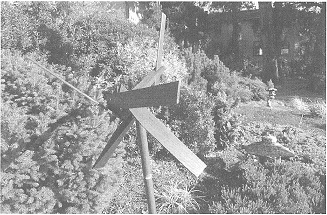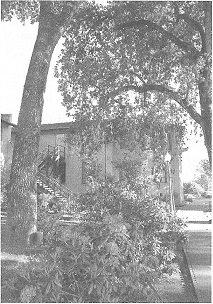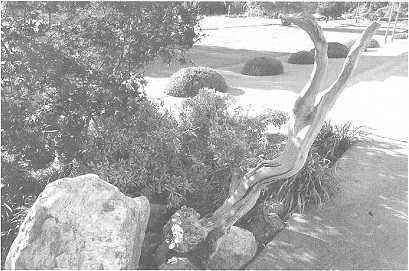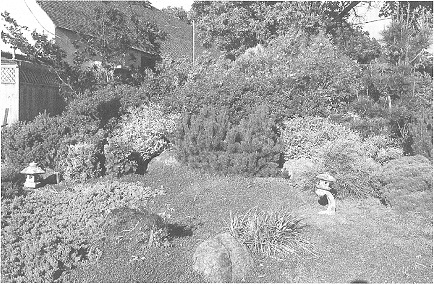|
在萬佛城,我的工作是園丁,也可說是花奴。今天想以花會友,讓大家瞭解一下目前聖城綠化工作狀況。
前些年向郡政府申請建「國際哲學倫理研究院」的建築許可證時,在其中一次聽證會中,有一位瑜珈市的居民批評我們:「你們連現有的校園都無法維護好,哪有能力去開發、維護新校區?」從那時起,大家才開始注重環境整潔、美化庭園。目前又因積極進行建築設計,其中也包括了庭園設計,於是又引起了大家對園藝的重視。法大也針對需要,開了一門園藝課,希望能培養一些對花草樹木有興趣的人,來學習園藝常識,以便在維護或改進現有及未來的花園。
照顧花園,不像在廚房幫忙洗菜、洗碗,或是掃樹葉那麼簡單,不是任何人一上場,可以馬上勝任。你也許會想:照顧花園,如拔草、澆水,這個工作誰都會!其實不然。連最基本簡單的工作,都需要稍具一些基本園藝常識,更別提修剪和施肥了;否則不該拔的被拔掉,或耐旱的植物被過多的水給淹死了,造成無謂損失。像牡丹花,在秋末後就落葉,光桿的枝條,到初春才再發新芽。曾經有棵牡丹花,在冬天被熱心的義工誤認為枯樹,就連根拔起丟掉。也有的人把它的枝桿剪短,結果就剩下牡丹葉,第二年春天,再生不出牡丹花了。又有一棵長得非常好的耐旱黃花樹,也是被熱心人士自動幫忙澆水而淹死。
再講到修剪,那更是損失慘重,相信大家都還記得,「君康真素齋」和行政辦公室旁,原來長滿了常綠的杜松,在不當修剪中,非但沒有美化,反而成了荒地。諸如此類幫倒忙,就越幫越忙,及造成的損失不計其數。所以敬請有愛心、善心、熱心人士,若願意幫忙,請先和園藝組有經驗的人商量一下,再動手。但根本解決之道,還是聖城多培養自己固定的園丁,按照一年四季進度表,進行保養。一個設計再好的花園,若不好好的照顧,遲早也就會變成廢園。
植物是活生生的,必須要繼續照顧才好。有時它蔓延過度,有時又枯死了,變化層出不窮,因此環境美化的工作永遠無法完畢。一個姣好討喜的花園不是偶然成就的,它應有良好設計、適當安置和適時維護。最精美的花園通常都經過四、五次的改進。園藝的維護有時間表,每一季都有不同的照顧。這些工作等不得你有空或有義工了再去做;若是設計和鋪設都做得好而沒有適時的維護,過一段時間這個花園就 衰敗了。
舉例來說:二十五年前,佛殿東北邊的山坡,當初也是種滿了杜松(杜松是非常健壯、長壽、耐旱、常綠的灌木),後來難民中心成立後,人手很多;有些人覺得杜松一年四季都是一個樣子,單調沒有變化,於是全部砍掉,改種很多美麗的花朵;等到難民中心結束,園子乏人照顧,只剩下些較耐旱會開花的灌木。94-95年間,以前的李果北居士(現在是近柔師)做了一個石頭花園,種了許多非常別緻的小花小草,深受大家喜愛;但她主要工作是教書,且膝蓋不便,無暇照顧,後來又因深造和出家被派往其他分支道場,以致野草叢生,蓋過她所種的小花小草,看起來雜亂不堪。現在又有法師發大心,準備做第三次的大翻修,希望能記取前人的教訓,做一個既耐看、能持久,又好照顧的花園。

一個看起來賞心悅目、又好照顧的花園,絕不是偶然的因緣巧合而促成的,是經過多方面的考慮。因為每一種植物就像人類一樣,都有它的個性、相貌和用途;要如何巧妙的搭配起來,真是一門學問。花園也有許多不同的風格派別,例如:英國式、法國式、義大利式、地中海式、日本式、中國式、自然派…等等。至於那一種最適合我們道場呢?有些人認為寺廟是修行的地方,庭園景觀要莊嚴肅穆、簡單大方,不要太花俏,尤其師父上人是禪宗祖師,要有禪味。有些人則認為要多種花,一年四季都有花開,既可供佛,又可接引眾生發菩提心,很多遊客來此,都是盯著花看和拍照片。比較實際派的,則說我們人手不夠,最好種不怕太陽,又不喝水、不需要照顧的仙人掌。比較會打算盤的則說,種花有什麼用,又不能當飯吃,還是種蔬菜、水果,替道場省錢比較重要。美國本地人,則喜歡有藥草香味的花朵,和較耐旱、有鄉村自然風格的花園。請問大家到底要聽誰的意見才對呢?其實佛陀早已告訴我們答案了,那就是中道。每一種意見都對、也都不對,每一種意見採納一些,很自然搭配在一起:以綠色耐旱、免修剪的樹木和灌木為主角,一小部份耀眼的花朵兒,則種在人來人往較多的地方為配角;萬一人手不夠,配角死了,還有主角撐場面。
記得上園藝課的第一堂課,老師就說:認識一種新的植物,就好像認識一個新的朋友;以後無論到那兒,看到你認識的植物,你就會想:「啊!我認識它!它叫…名字!」這就是為什麼從亞洲來的外國人,總是要想盡辦法把認識的「老朋友」移民或偷渡過來,例如桂花、梅花、玉蘭花…等等。當其他亞洲朋友,在此看到這些熟悉的花樹,也會特別的高興;就好像與老朋友異地重逢,總是份外親切。這也是美國本地人難以瞭解、也不滿意的地方 ── 亞洲人總是愛種那些又怕霜凍、又浪費水的植物!因此鼓勵大家來上課,多認識一些本地的新朋友,多和本地生的植物溝通打交道,不要捨近求遠。
上人常說:日月星辰、山河大地,萬事萬物,都在說法,但看我們能否用心體會。《法華經》中的〈藥草喻品〉提到:佛法如大雨,上等根性的眾生,如大樹,可吸收較多的雨水;在同一地點生長的小草,如下等根性眾生,則吸收到的雨水,自然也少。這個比喻非常清楚明瞭。不知各位有沒有想過:大樹是如何長成一棵大樹的?在玫瑰花園裏,有一棵橡樹和一棵枇杷樹,每年春天,我都要忙著拔掉新發出來的樹苗。枇杷樹苗的根很淺,而且是橫著長;然而橡樹,只有一根粗壯的主根,通常兩吋高的樹苗,有六七吋深的根。一棵百呎高的橡樹,它的根,就有百呎深;橡樹的寬度,就是根部的面積。老師說:橡樹根部的長度,如加起來,有百萬哩長;正因如此,才能支撐地面高大的樹幹,耐得住狂風侵襲;又因根部吸水力特強,葉子不散發水份,才能度過加州無雨的夏天,而能成為樹王之王──即使是有名的紅木,長得雖比橡樹高,但根不深,容易倒,所以比不上橡樹。它的木材,屬於高級硬木,是上好的建材。反觀枇杷樹,則剛好相反;小苗長到6-7吋高,根部才2吋深,而且是很多橫著的鬚根,所以枇杷樹成不了大樹。
我從觀察這兩棵樹生長的過程,體會到上人常常開示我們,要「韜光養晦」;上人又說:「養成大拙方為巧,學到如愚始見奇」,並且對早先的入室出家弟子,管教非常嚴格,作風保守。當初我剛來萬佛城時,心裏很懷疑:如何能把佛法在西方發揚光大呢?師父也知道我有這個疑念,有次他告訴我,他是來美國斬荊闢棘,把佛教在美國紮根打基礎的。我現在徹底瞭解師父的作法,正如小橡樹苗,初期只長根,等長了5呎深之後,才長枝葉。修行亦復如是,也要學橡樹根,道心堅固、一門深入;並發廣大願,終有一生,我們會修到像大樹般的上等根性眾生,蒙受較多的法雨滋潤。
曾經遇到一位很鄉土、很平凡的園藝大師,說了一句很有智慧的話,讓我終生難忘:「不是我創造了花園,而是花園創造了我!」

|
|
I’m a gardener at the City of Ten Thousand Buddhas (CTTB); or, you could call me a slave of flowers. Today, I would like to use it as topic to share my insight with you friends and update you on the work of greening CTTB.
A few years ago during the process of applying for the building permit for IIP&E [the International Institute for Philosophy and Ethics], in one of the hearings a Ukiah resident brought up his doubt about our ability to maintain our existing campus, how much the less to maintain the future new big project. Thereafter, people started to pay attention to campus upkeep and gardening. Recently, we are in intensive process of designing IIP&E which includes landscaping as well. This has caused people to pay attention to landscaping and gardening again. Dharma Realm Buddhist University (DRBU) also started a new landscaping class to meet these needs. We definitely need more people to take care both existing and future gardens on campus.
Gardening work is not as simple as washing dishes or vegetables in the kitchen. The most basic tasks in gardening are weeding and watering. You might think that anybody can do this kind of easy work. Actually, it is not as easy as you think. Even the most basic gardening jobs require basic knowledge on gardening; much the more so for tree trimming and applying fertilizer. Otherwise, what shouldn’t be uprooted can be uprooted, or those drought-enduring plants can be “drowned” by someone’s overly watering — an unnecessary loss.
For example: tree peony is a deciduous flower which means the leaves fall off in the winter and the trunk looks like dead branches without the leaves. One time, a kind volunteer thought it was a dead plant and pulled it out. Another person cut it down. It was too small to bloom in that coming spring. Another example was a very drought tolerant small tree named ‘Fremontodendron’ which bears yellow flower in the spring. One summer, it died because a kind volunteer gave it too much drink.
Furthermore, we lost a lot of plants because of improper pruning. I believe that most of you still remember that there was a group of nice green Juniper in front of the Chun-Kang Restaurant and in the parking lot by the Administration Office. Someone with a good intention tried to prune the bush to make it look nicer. Unfortunately, it turns out that the plants were killed due to the lacking of pruning knowledge.
As a result, it was a big loss for the temple. Not only do we need to spend more money for new plants but also takes a lot of time and labor to redo the garden. Although people begin with a good intention to help, sometimes the more you help the busier we are. Therefore, we are happy to have more sincere, kind-hearted volunteers to help, but please make sure to contact those experienced members of the gardening group for advice or instructions before you start with your own way. After all, the most fundamental way to solve the problem is to train more people — have them learn more about horticulture so as to maintain our gardens in accord with the four seasons. The best garden, without proper care, will turn into a waste garden.
It is only as good as the maintenance continues because the plant is a living thing. Sometimes, it overgrows and sometimes it dies. Therefore, the changes are always evolving and landscape maintenance will never completely finish. A successful garden doesn’t come by chance. It has to be a well designed, proper installed and timely maintained. Normally a finest garden takes 4-5 times improvement. The garden has to be maintained according to the schedule. There are things that have to be taken care of in each season. It is not something that you can wait until you have spare time or when we have volunteers show up. If both design and construction are done well but without a timely maintenance, the garden will degenerate as time goes by.
For instance, twenty-five years ago, on the northeast hillside of the Buddha Hall, it was covered completely with the Juniper which is a very drought tolerant shrub. Later, CTTB established a Vietnamese Refugee Center and there were a lot of refugees around. People felt that the evergreen Juniper is boring and ugly. Therefore, they cut down the entire Juniper and replaced it with some beautiful flowers. It looks very pretty for several years. However, after the Refugee Center closed down, no one has time to take care of it. We lost most of the flowers except some very drought tolerant bush, such as rockroses and rosemary. During the year of 94-95, Rebecca Lee (Jin Rou Shr) used many little drought tolerant plants and made a rock garden. It was admired by many CTTB residents and visitors. However, Rebecca was a full time teacher and have problem with her knees. She hardly had time to take care the rock garden. Later, she left and lived in other branch monastery. Even though that she used the weed fabric to cover the ground, after a period of time the weeds was so vigorous it had taken over that pretty rock garden and became very messy. Now, there is a Dharma Master determined to try the third time to retrofit that area. From the lessons that we’ve learned, I hope she will be very careful in selecting plants.
A success garden doesn’t come by chance. It takes a lot of thinking and planning because every plant has its own character, function and form. It takes experience and knowledge in horticulture and landscaping to coordinate them well together harmoniously. There are many styles of gardens, such as: English style, French style, Mediterranean style, Japanese style, Chinese style, California country style…etc. Now, which style fits the monastery? Some people think that monastery is a place for people to cultivate and it should be simple and adorned, not too jazzy or too spiffy. Especially, our Venerable Master is the Zen patriarch and our landscaping should have a Zen flavor. Some other people think that we should plant the flowers that bloom all year round and we can offer the flowers to the Buddha. Also, the visitor loves to look and take picture with the flowers. Some practical people said that since we don’t have enough labor sources, it’s better to plant the carefree cactus, which takes full sun and doesn’t need to drink the water in the summer. Some frugal people said it’s better to grow some plants that you can harvest such as vegetables and fruits. It saves a lot of money. Some American naturalists prefer California country style garden which consists of wild flowers herbs and indigenous plants. So, whose opinion is right? I thought about it for many years. Finally, I figure out that the Buddha had already told us the answer. It is the middle way, not too extreme to either side. Everybody is right and we can combine everyone’s favorite idea tactfully and naturally integrate these ideas into one that satisfies everyone’s wish. We can select the native carefree trees and shrubs as the main structure of the garden and use some small colorful annual and perennial flower which takes a lot of maintenance as the supporting role. If we’re short of people, we can give up the flower and it won’t change the main structure.

I remember in the first landscape gardening class, our teacher said that to know a plant is to make a new friend. Later, wherever you go and whenever you see the plant, you’ll say: “I know its name is so and so.” This is the reason why Chinese people like to immigrate or smuggle their “old friends” to the US, such as: Osmathus, Flowering ume, Michela alba.etc. Most of Chinese would get very excited whenever they see these familiar plants in CTTB because they are just like their old friends. This is the reason that the local Americans can’t understand, “Why do the Chinese people always like to plant those finicky plants that are frost tender or require a lot of water?” So, I like to encourage people to come to the class to learn more about local native plants and make friends with them. Don’t drop what is near and go for what is afar /seek far and wide for what lies close at hand.
The Venerable Master often said that the sun, the moon, the stars, the earth and every thing that you see is speaking the Dharma. We’ll understand Dharma if we observe it with our sincere and subtle mind. In the Herbal Chapter of the Dharma Flower Sutra, it says that the Dharma is just like the rain; living beings that have very good nature are just like the big trees which can receive more rainfall. Livings beings that have fewer roots are just like the small grass which receives less rainfall. This is a very simple and clear analogy. Has anyone thought about how a tree grows into a big tree? There is an oak tree and a loquat tree in the rose garden. Every spring, I have to pull the seedling of these two trees. I notice that the root of the loquat tree is very shallow. On the contrary, the oak tree has a main strong deep root. The length of the root is three times of the trunk when it sprouts the first year. The root of the 100 ft tall oak tree is also 100 ft deep. The roots grow as wide as the oak tree. The root of a big oak tree summed up about million miles long so that it can support the big and heavy trunk and branches above ground. Because the oak tree is so deeply rooted, it can survive the whole summer without any raindrop or water. In horticulture realm, the oak tree is the king of all the trees. The famous redwood tree, taller than the oak tree, can be easily toppled because it’s shallow rooted. The quality of oak wood is high and hard; it’s top building material. In comparison, the loquat tree’s root extends for 2 inches deep when its sprout grows 6-7 inches tall. Besides, there are many horizontal bearded root, that’s why loquat tree can’t become a big tree.

From observing the growing process of these two trees, I realized why the Venerable Master often instructed us to conceal our talents and not to show off. The Venerable Master also said,
“When one can train oneself to appear as if foolish, Then one’s genuine cleverness comes forth. If one can study until one appears dull, Then one’s real talents begin to appear.” He taught his monastic disciples in early days very strictly and kept a conservative style.
When I first came to the CTTB, I was wondering how we could propagate the Buddha Dharma to the Westerners with such strict and conservative attitude. Shr Fu knew what was on my mind. During a phone conversation, he explained to me that the purpose for him to come to the U.S. was to clear the obstacles on the ground and lay a strong and solid foundation for the Buddhism in the west. From observing the growth of the oak trees, I then understood what Shr Fu had told me. It is just like the way the oak tree grows. It concentrates in growing the roots first without growing much of its the branches and leaves above ground. It starts to develop the top only until the roots reach 3-5 feet deep under the ground. In cultivation, we should follow the growing path of the oak trees – make a strong Bodhi resolve and a great vow to cultivate single-mindedly. The vow that we make should be just like the roots of the oak trees – deep and vast. We should cut off our false thoughts and outflow, which is just like the leaves of the oak trees – hardly evaporate any moisture. If we can cultivate just like how the oak trees grow, it is certain that one life in the future we will become a living being with superior roots which can receive more rainfall.
One time I met a very common ordinary landscaper who had told me a wise saying that I can never forget. “It is not me who creates the garden. It is the garden that creates me instead.”
|